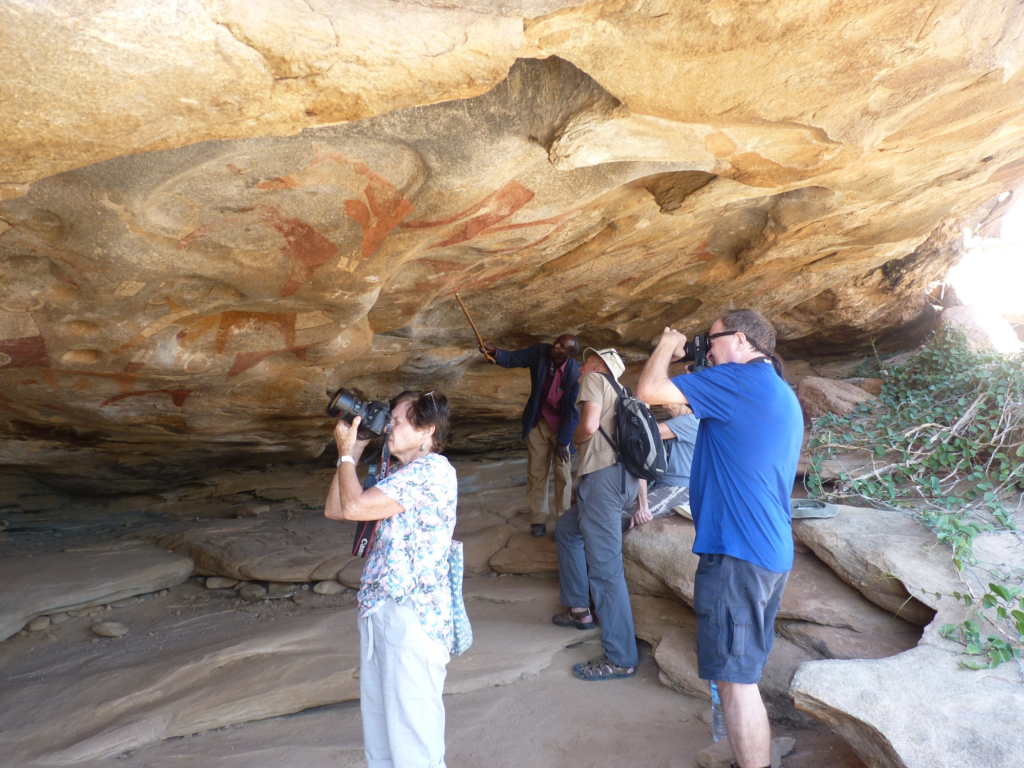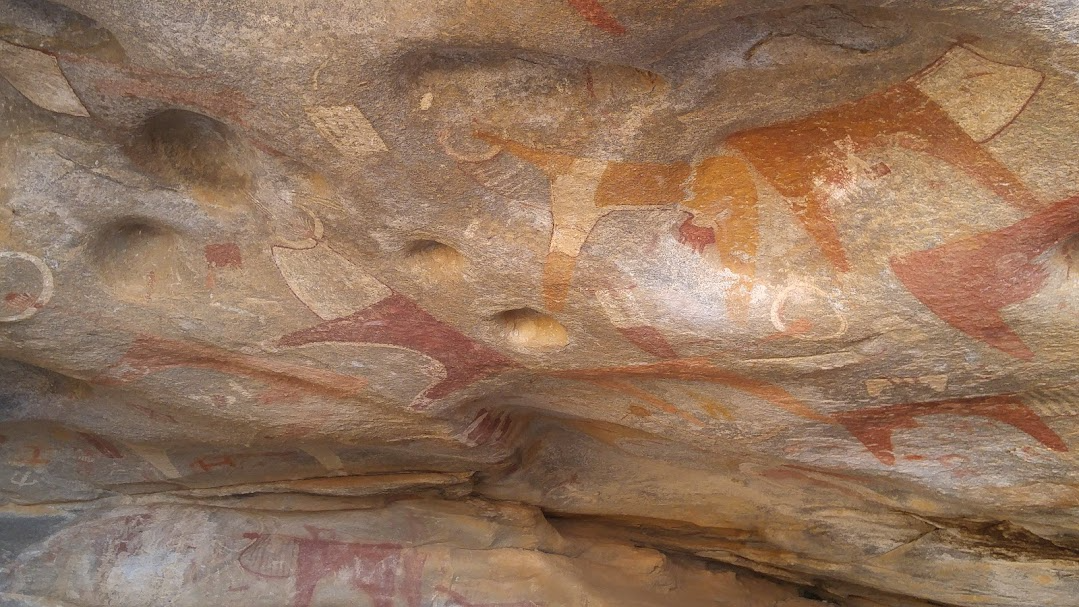Exploring Laas Geel: Ancient Art’s Beauty in Somaliland
Located in the Republic of Somaliland, a self-declared state internationally recognized as an autonomous region of Somalia, it is one of Africa’s hidden gems – Laas Geel. This ancient rock art site has been attracting visitors worldwide due to its unique and breathtaking beauty.
Discovered in 2002 by a team of French archaeologists, Laas Geel has quickly become a must-visit destination for history and art enthusiasts. With its stunningly well-preserved paintings dating back over 5,000 years, Laas Geel offers a glimpse into the rich cultural heritage of the Horn of Africa region. In this article, we will take a closer look at this incredible place and discover why it is considered one of the most influentialworld’s rock art sites.
Table of Contents
History and Significance of Laas Geel

The Laas Geel cave formations on the outskirts of Hargeisa in Somaliland are one of the most significant archaeological discoveries in the Horn of Africa, providing a vivid glimpse into ancient pastoral life.
Discovered by a French archaeological team in 2002, these caves feature some of the oldest known cave paintings in the region, dating back to circa 3,500-2,500 BCE. The paintings at Laas Geel are remarkably well-preserved, offering unparalleled insights into prehistoric life.
The rock art at Laas Geel is predominantly composed of vivid depictions of domesticated cattle alongside human figures, suggesting a society that deeply valued livestock and possibly practiced cattle herding as a way of life.
These images are executed in a distinctive Ethiopian-Arabian style, similar to other rock art found in Somaliland, highlighting a cultural continuity in the region’s prehistoric era. The depiction of decorated cattle, some adorned with ceremonial robes, suggests a complex societal relationship with these and other animals, hinting at ritualistic practices or social status indicators.
Laas Geel’s significance extends beyond its artistic value; it offers critical insights into the early domestication of animals in the Horn of Africa. Some researchers propose that the paintings represent domesticated African aurochs, a now-extinct wild ancestor of modern cattle. This evidence challenges previously held beliefs about the origins and spread of pastoralism in Africa.
Despite its historical importance, Laas Geel remained unknown to the international community until its discovery in the early 2000s. Since then, it has attracted interest from archaeologists and tourists alike, highlighting the need for preservation efforts to protect this invaluable window into humanity’s past. The site embodies the rich cultural and historical heritage of Somaliland, offering a unique perspective on the development of human societies in the region. As such, Laas Geel is a testament to the artistic expression of prehistoric peoples and a crucial archaeological site for understanding human history in the African context.
Depicted Animals and Their Meaning

The Laas Geel caves, with their ancient rock art, provide a fascinating insight into the prehistoric life of the Horn of Africa. The paintings, dating back to between 3,500 and 2,500 BCE, feature a variety of animals, each potentially symbolizing different aspects of the society that created them.
Central to these depictions are cattle, which dominate the artwork and are portrayed with remarkable detail, including ceremonial robes and distinctive plastrons around their necks. This suggests that cattle were paramount to the community, possibly reflecting wealth, status, or spiritual significance. The elaborate decoration of these animals indicates a deep cultural reverence, perhaps linked to fertility rituals or social ceremonies.
Besides cattle, the presence of canines in the art hints at the early domestication of dogs, suggesting their role as companions or helpers in herding and hunting. The depiction of a giraffe, among other wild animals, illustrates the region’s rich biodiversity and may symbolize the harmony between humans and nature or the hunting prowess of the community. Including various wildlife alongside domesticated animals could also represent the peoples’ deep understanding and interaction with their environment, essential for their survival and prosperity.
The Laas Geel’s beautiful prehistoric cave paintings, through their depiction of animals, offer a window into prehistoric society’s beliefs, values, and everyday life. The prominence of livestock in the art suggests a pastoralist culture, where animal husbandry was a source of sustenance and intertwined with social and religious practices.
This rich tapestry of life captured in stone reflects the complex relationship between humans and animals, highlighting the significance of sustaining and enriching the community’s life. In this way, las geel stands as a testament to the ancient roots of pastoralism and the profound impact of animals on human culture and spirituality in the Horn of Africa.
Preservation and Future of Laas Geel
Despite its historical and cultural significance, the Laas Geel caves face threats from natural erosion and human activities. The fragile rock art requires careful preservation efforts to protect it for future generations. In recent years, there have been initiatives to raise awareness about Laas Geel’s importance and support conservation projects that safeguard the site.
One example is the “Save Laas Geel” project, a collaboration between local authorities and international organizations to preserve the site’s integrity. The project has implemented measures such as building protective shelters, restricting visitor access to specific areas, and educating local communities on the value of preserving their cultural heritage.
The future of laas gaal remains in the hands of these preservation efforts, as well as the continued interest and support from tourists and researchers. As one of Africa’s most significant archaeological discoveries, it offers a unique opportunity to understand the region’s early development of human societies.
As such, we must prioritize its preservation to benefit present and future generations. So, governments and organizations must continue investing in conservation efforts to safeguard this invaluable site and ensure its legacy for ages to come. As we continue to unravel the mysteries of human history, Laas Geel will undoubtedly remain a key piece in the puzzle of our ancient origins in the Horn of Africa.
Why Visit Laas Geel?
Safari Travel Tour and Culture
Laas Geel is an important archaeological site and a fascinating destination for tourists interested in history, culture, and nature. The site offers a unique opportunity to witness ancient rock art and explore the prehistoric way of life in the Horn of Africa.
Tourists can visit the caves, where they will be guided by knowledgeable guides who provide insights into the paintings’ significance and historical context. They can also explore the surrounding area, which offers stunning views of the Somaliland landscape and a chance to observe local wildlife.
Moreover, visiting Laas Geel supports the preservation efforts of the site and contributes to the local economy, promoting sustainable tourism in the region.
Mistakes that Others Make

The preservation and conservation efforts for Laas Geel highlight the importance of responsible tourism. Unfortunately, there have been instances where visitors have caused damage to the site, either through vandalism or unintentional actions.
One common mistake is touching or scratching the paintings, which can cause irreversible damage to the delicate rock surface and paint. Another mistake is littering or leaving behind any waste, which not only damages the environment but also poses a threat to the site’s preservation.
Visitors should also refrain from using flash photography, as it can cause fading and deterioration of the paintings over time. It is essential to follow all guidelines and instructions when visiting La Gaal to ensure its preservation for future generations.
In addition, visitors should also be mindful of the local communities and their customs, respecting their cultural heritage and way of life. This includes obtaining proper permits and permissions before visiting the site and supporting local businesses and initiatives promoting sustainable tourism.
By being responsible tourists, we can contribute to preserving Laas Geel’s rich history and culture for years to come. Let us learn from the mistakes of others and commit to protecting this invaluable site for future generations to experience and appreciate. Responsible tourism is crucial in ensuring the preservation and sustainability of cultural sites like Laas Geel. So, let us all do our part in preserving this unique window into our past.
Can We Learn from Laas Geel?
The importance of Laas Geel extends beyond its preservation and tourism value. It also offers valuable lessons for modern society, particularly in our relationship with nature and animals.
The pastoralist culture depicted in the paintings is a prime example of sustainable living, where humans coexist with nature and rely on animal husbandry for survival. This serves as a reminder of the importance of harmonious relationships between humans, animals, and the environment.
Moreover, Laas Geel’s artwork showcases the close connection between humans and animals in terms of cultural and spiritual beliefs. This highlights the significance of animals in shaping human culture and emphasizes the need to respect and protect all life forms on our planet.
In essence, Laas Geel teaches us about our past and provides valuable insights and reminders for our present and future. By learning from this ancient site, we can strive towards a more sustainable and harmonious relationship with nature, just as our ancestors did thousands of years ago.
So, let us continue to appreciate and preserve Laas Geel for human representations and all it represents – a testament to human history and a lesson for the future. Let us remember the importance of keeping our cultural heritage, as it shapes our identity and reminds us of our place in the world.
How to Support Laas Geel’s Preservation
There are various ways in which individuals can support the preservation of Laas Geel. The most important and direct way is by visiting the site and following all guidelines and instructions for responsible tourism.
Additionally, supporting local communities through purchasing goods and services, such as souvenirs or guided tours, also contributes to the conservation efforts of the site.
Furthermore, spreading awareness about Laas Geel and its significance can help generate support and funding for preservation initiatives. This can be done through social media, word of mouth, or even organizing fundraising events.
Lastly, individuals can also consider donating directly to organizations or institutions that preserve Laas Geel. Every contribution counts towards safeguarding this precious piece of history.
FAQs
What makes the prehistoric cave paintings at Laas Geel so significant?
The prehistoric cave paintings at Laas Geel are considered among Africa’s oldest and most well-preserved rock art sites. Estimated to be around 5,000 years old, these paintings provide a vivid window into the past, showcasing a level of artistic sophistication and understanding of animal anatomy that is remarkable for the period.
Can you describe the environment around Laas Geel and how it contributes to the preservation of the rock paintings?
Laas Geel is nestled within an arid desert landscape, characterized by its rugged terrain and sparse vegetation. This region of Somaliland is marked by rocky outcrop and shallow caves where the ancient paintings are found. The dry climate has played a crucial role in the preservation of the rock paintings over millennia.
What types of imagery can visitors expect to see during a visit to Laas Geel?
Visitors to Laas Geel can expect to see an array of stunning rock paintings that depict a variety of scenes and figures. Most prominent among these are the vividly colored paintings of cattle, which are often shown with elaborate decorative patterns, indicating their central role in the community’s culture.
Why has Laas Geel remained in relative obscurity until recent years?
Laas Geel remained in relative obscurity until its discovery by a team of French researchers in 2002, largely due to the region’s political instability and the lack of infrastructure for tourism and archaeological research. Since its discovery, efforts have been made by the Somaliland government, with support from international organizations, to preserve and promote the site.
Conclusion
As we have seen, Laas Geel is a unique and significant destination in the Horn of Africa. It offers a glimpse into our ancient past and holds valuable lessons for present and future societies. By supporting responsible tourism and preservation efforts, we can ensure this invaluable site remains intact for generations.
Let us all do our part in preserving Laas Geel and promoting sustainable regional tourism. Together, we can protect and appreciate this vital piece of human history. So, add Laas Geel to your list of must-visit destinations and experience the magic for yourself!
Let us continue to connect with our past through this ancient bridge while also shaping a better future for ourselves and our planet. Laas Geel will always stand as a testament to the resilience and ingenuity of human beings, reminding us of our place in the world and how we can learn from our past to create a better tomorrow.







